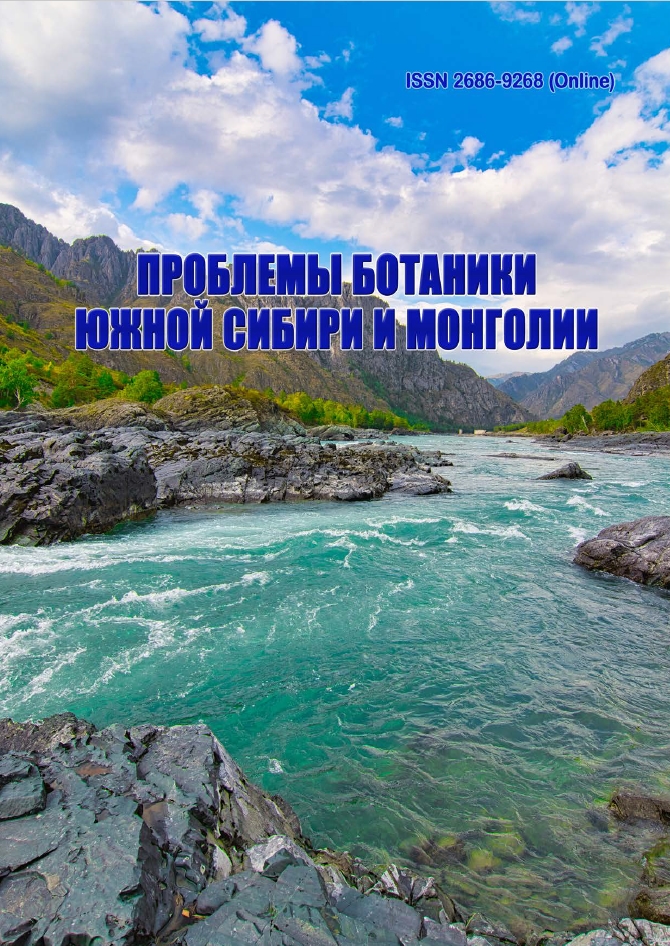Investigation of the ecological and climatic niche of the protected species Erythronium sibiricum (Fisch. et Mey.) Kryl.
УДК 582.572.2(574.38)
Abstract
The Siberian kandyk (Erythronium sibiricum (Fisch. et Mey.) Kryl.) is listed in the Red Books of the Russian Federation and in the regions where it grows. The Siberian kandyk is widespread in Southern Siberia and Mongolia. This species has many useful qualities, for example, it is used for decorative purposes, for introduction, in folk medicine and for obtaining honey. The purpose of the work is to identify the ecological and climatic niche of the species and build on its basis a model of suitable habitats in the conditions of modern climate. The MaxEnt 3.4.4 and BIOCLIM methods implemented in the statistical programming environment R (CRAN) were chosen as tools for analysis and modeling. For visualization and information of previously obtained layers, the ArcGIS 10.8 program is convenient. As a result of the work done, it became obvious that the current distribution of the species as a whole corresponds to the obtained model of distribution of favorable conditions for the growth of the species, and the reduction in the number of plants is caused by other reasons.
Downloads
Metrics
References
Мельченко В. П., Андреев В. Н., Жукова П. Г. Редкие и исчезающие растения Сибири / отв. ред. Л. И. Малышев, К. А. Соболевская. - Новосибирск: Наука: Сибирское отд-ние, 1980. - 224 с.
Амельченко В. П., Катаева Т. Н., Зайкова Е. В. Кандык сибирский - Erythronium sibiricum // Красная книга Томской области. Изд. 2-е, перераб, и доп. - Томск: Печатная мануфактура, 2013. - С. 318-319.
Ачимова А. А. Растения Горного Алтая в обычаях и традициях алтайцев. - Барнаул, 2012. - С. 41.
Зубкус Л. П. Некоторые особенности роста и развития кандыка сибирского - Erythronium sibiricum (Fischer et Mey. Kryl.) в природе. // Тр. Бот.сада Западно-Сибирского филиала АН СССР, 1956. - Вып. 1. - С. 33-38.
Красников А. А. Кандык сибирский - Erythronium sibiricum // Красная книга Новосибирской области. Животные. Растения и грибы / отв. ред. В. В. Глупов, Д. Н. Шауло. - Новосибирск: М-во природных ресурсов и экологии Новосибирской обл., 2018. - С. 390.
Крылов П. Н. Флора Западной Сибири // Изв. Имп. Томск. ун-та. - Томск, 1929. - Вып. 3. - 641 с.
Куваев В. Б. Кандык сибирский // Красная книга Российской Федерации (Растения и грибы). - Москва, 2008. -С. 319-320.
Куприянов О. А. Кандык сибирский - Erythronium sibiricum // Красная книга Кузбасса. Том I. 3-е издание, перераб. и доп. - Кемерово: «ВЕКТОР-ПРИНТ», 2021. - С. 68.
Лащинский Н. Н. Высшие сосудистые растения // Флора Салаирского кряжа / отв. ред. Н. Н. Лащинский. -Новосибирск: Гео, 1997. - С. 155-251.
Лучник З. И. Декоративные растения Горного Алтая. - Москва: Сельхозгиз, 1951. - 244 с.
Определитель растений Республики Алтай / И. М. Красноборов и др.; отв. ред. И. М. Красноборов, И. А. Артемов. - Новосибирск: Изд-во СО РАН, 2012. - 701 с.
Положий А. В. Кандык сибирский - Erythronium sibiricum // Красная книга Томской области. - Томск: Изд-во Том. Ун-та, 2002. - С. 258-259.
Свиридонов Г.М. Полезные растения Горного Алтая: Применение, рацион. использование и охрана. - Горно-Алтайск: Алт. кн. изд-во. Гор.-Алт. отд-ние, 1978. - 231 с.
Степанов Н. В. Кандык сибирский - Erythronium sibiricum // Красная книга Красноярского края. В 2 т. Т. 2: Редкие и находящиеся под угрозой исчезновения виды дикорастущих растений и грибов. Изд. 2, перераб. и доп. -Красноярск, 2012.- С. 198.
Терёхина Т. А., Копытина Т.М. Кандык сибирский - Erythronium sibiricum // Красная книга Алтайского края. Том 2. Редкие и находящиеся под угрозой исчезновения виды животных. - Барнаул: Изд-во Алт. Ун-та, 2016. -С. 126-127.
Фризен Н. В. Erythronium L. - Кандык // Флора Сибири. Araceae - Orchidaceae. - Новосибирск: Наука, 1987. - С. 103, 199.
Brown J. L. SDMtoolbox: a python-based GIS toolkit for landscape genetic, biogeographic and species distribution model analyses // Methods in Ecology and Evolution, 2014. - Vol. 5, N 7.- P. 694-700.
Busby J. R. BIOCLIM - a bioclimate analysis and prediction system // Nature Conservation: Cost Effective Biological Surveys and Data Analysis / Margules C. R., Austin M. P. (eds.). - CSIRO: Melbourne. 1991. - P. 64-68.
ESRI ArcGIS Desktop and Spatial Analyst Extension: Release 9. Environmental Systems Research Institute, Redlands, CA, 2012. Available at: http://www.esri.com (Accessed: 27.01.2016).
GBIF - Global Biodiversity Information Facility. URL: https://doi.org/10.15468/dl.esjzs6 (Accessed 05 May 2021)
Hijmans R. J., Cameron S., Parra J. Climate date from WorldClim, 2004. URL: http://www.worldclim.org (Accessed 20 May 2021).
Hijmans R. J., Guarino L., Jarvis A. et. al. DIVA-GIS, version 5.2. Manual. 2011. URL: http://www.diva-gis.org/ docs/DIVA-GIS5_manual.pdf (Accessed: 18 April 2016)
Osorio-Olvera L., Lira-Noriega A., Soberon J., Townsend Peterson A., Falconi M., Contreras-Diaz R. G., Martinez-Meyer E., Barve V., Barve N., ntbox: an R package with graphical user interface for modeling and evaluating multidimensional ecological niches. Methods Ecol Evol. Accepted Author Manuscript, 2020. DOI: 10.1111/2041-210X.13452
Phillips S. J, Anderson R. P, Schapire R. E. Maximum entropy modeling of species geographic distributions // Ecological Modelling, 2006. - Vol. 190. - P. 231-259.
Phillips S. J., Dudich M. Modelling of species distribution with Maxent: new extensions and a comprehensive evaluation // Ecography, 2008. - Vol. 31.- P. 161-175.
Plantarium. Plants and lichens of Russia and neighboring countries: open online galleries and plant identification guide. 2007-2022. URL: https://www.plantarium.ru/lang/en.html (Accessed 05 May 2022).
Scheldeman X., Van Zonneveld M. Training manual on spatial analysis of plant diversity and distribution. - Rome: Biodiversity International, 2010. - 180 p.



